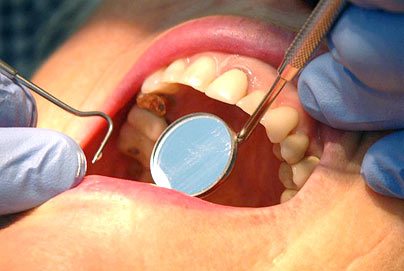 MORE THAN **25** YEARS OF DENTAL EXCELLENCE | | ISO 9001:2000 CERTIFIED |
A2 AASHIRWAD, II CROSS LANE, LOKHANDWALA COMPLEX, ANDHERI (WEST), MUMBAI 400053, INDIA | 2632 8682 / 3082 7053 / 98193 63215 |
 MORE THAN **25** YEARS OF DENTAL EXCELLENCE | | ISO 9001:2000 CERTIFIED |
A2 AASHIRWAD, II CROSS LANE, LOKHANDWALA COMPLEX, ANDHERI (WEST), MUMBAI 400053, INDIA | 2632 8682 / 3082 7053 / 98193 63215 |
|
DENTAL NEWS ARCHIVES 310 |

|
Dentists' drill and toothbrush under threat from new inventionsBy Rebecca Smith, Medical EditorLast Updated: 11:37AM BST 21 Jul 2008The dentists' drill could be consigned to the past while the future of the toothbrush is under threat, with the arrival of two radical new inventions that could be available within five years.

Dental
researchers believe an alternative to drilling could be ready for use within
five years Photo: PA Scientists at Leeds Dental Institute have created a solution that mimics the way the body forms new teeth, which can be used to repair holes naturally without the need for drilling and filling. The same researchers have also formulated a mouthwash that kills the bacteria that cause plaque when a light is shone into the mouth. They believe the mouthwash could be available in as little as three years or less while the alternative to drilling could be ready for use within five years. The alternative to drilling comes from a new protein which allows the body to repair holes in the enamel on the surface of the tooth naturally. It creates a scaffold which attracts the minerals that form enamel in the same way as the body creates new teeth. The substance can be painted on teeth while decay is in the early stages to fill tiny holes before they become large holes full of decay. Prof Jennifer Kirkham, Research Director at the institute, said: "I can't bear the noise of the drill and it is surprising how many people say just the sound is enough to instil fear. We looked at a way to treat early decay and avoid drilling." The same treatment could also be used to fill tiny holes in the teeth's dentine, which causes intense sensitivity to hot and cold food or drinks. Because the protein involved in the treatment is completely new it must go through safety checks which are already under way. It is hoped it can enter trials early next year with a view to gaining a licence within five years, Prof Kirkham said. She added: "We feel confident that this is a major step change for the future." The other invention is a mouthwash using a molecule that is absorbed by bacteria in the mouth. When activated by a bright light it destroys the bug from within. There is no risk to the patient if any of the mouthwash is swallowed, as the molecule is completely safe and is already in use in the food industry. The method, called photo dynamic therapy, has been developed from cancer treatment and was first looked at as a way of helping disabled patients to look after their teeth if they cannot use a normal toothbrush. But Prof Kirkham said the scope for its use is much wider. She said: "It is a safe alternative way of improving oral hygiene for those patients for whom brushing is not feasible or as an adjunct to brushing. "At the moment we are not saying it is going to take over from brushing because the trials have not been done yet. We have to look at how much it is going to cost, at the moment is it is very cheap. We would wish to explore its full potential across the whole patient community and look at all the potential benefits over and above what is already out there." She said the method could also be used to treat gum disease which is a major cause of tooth loss. It could be inserted below the gum line, by a hygienist during a routine scale and polish, with a tiny fibre optic light source to destroy the bacteria. More work is needed to identify the optimum light intensity and duration that patients can tolerate along with trials on different handheld light sources and mouthwash tastes. Bacteria do not become resistant to the treatment in the same way as they do to antibiotic drugs which are used to treat severe gum disease. Prof Kirkham said she hoped it would be on the market within three years. The team will be based at the new translational research facility due to open next year after a £1.5 million investment by the University of Leeds. |
 |